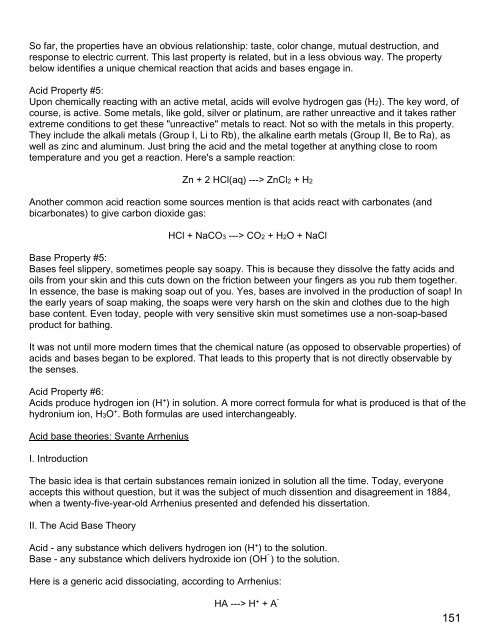(FINAL) Chemistry Notebook 2016-17
- No tags were found...
Create successful ePaper yourself
Turn your PDF publications into a flip-book with our unique Google optimized e-Paper software.
So far, the properties have an obvious relationship: taste, color change, mutual destruction, and<br />
response to electric current. This last property is related, but in a less obvious way. The property<br />
below identifies a unique chemical reaction that acids and bases engage in.<br />
Acid Property #5:<br />
Upon chemically reacting with an active metal, acids will evolve hydrogen gas (H2). The key word, of<br />
course, is active. Some metals, like gold, silver or platinum, are rather unreactive and it takes rather<br />
extreme conditions to get these "unreactive" metals to react. Not so with the metals in this property.<br />
They include the alkali metals (Group I, Li to Rb), the alkaline earth metals (Group II, Be to Ra), as<br />
well as zinc and aluminum. Just bring the acid and the metal together at anything close to room<br />
temperature and you get a reaction. Here's a sample reaction:<br />
Zn + 2 HCl(aq) ---> ZnCl2 + H2<br />
Another common acid reaction some sources mention is that acids react with carbonates (and<br />
bicarbonates) to give carbon dioxide gas:<br />
HCl + NaCO3 ---> CO2 + H2O + NaCl<br />
Base Property #5:<br />
Bases feel slippery, sometimes people say soapy. This is because they dissolve the fatty acids and<br />
oils from your skin and this cuts down on the friction between your fingers as you rub them together.<br />
In essence, the base is making soap out of you. Yes, bases are involved in the production of soap! In<br />
the early years of soap making, the soaps were very harsh on the skin and clothes due to the high<br />
base content. Even today, people with very sensitive skin must sometimes use a non-soap-based<br />
product for bathing.<br />
It was not until more modern times that the chemical nature (as opposed to observable properties) of<br />
acids and bases began to be explored. That leads to this property that is not directly observable by<br />
the senses.<br />
Acid Property #6:<br />
Acids produce hydrogen ion (H + ) in solution. A more correct formula for what is produced is that of the<br />
hydronium ion, H3O + . Both formulas are used interchangeably.<br />
Acid base theories: Svante Arrhenius<br />
I. Introduction<br />
The basic idea is that certain substances remain ionized in solution all the time. Today, everyone<br />
accepts this without question, but it was the subject of much dissention and disagreement in 1884,<br />
when a twenty-five-year-old Arrhenius presented and defended his dissertation.<br />
II. The Acid Base Theory<br />
Acid - any substance which delivers hydrogen ion (H + ) to the solution.<br />
Base - any substance which delivers hydroxide ion (OH¯) to the solution.<br />
Here is a generic acid dissociating, according to Arrhenius:<br />
HA ---> H + + A¯<br />
151





